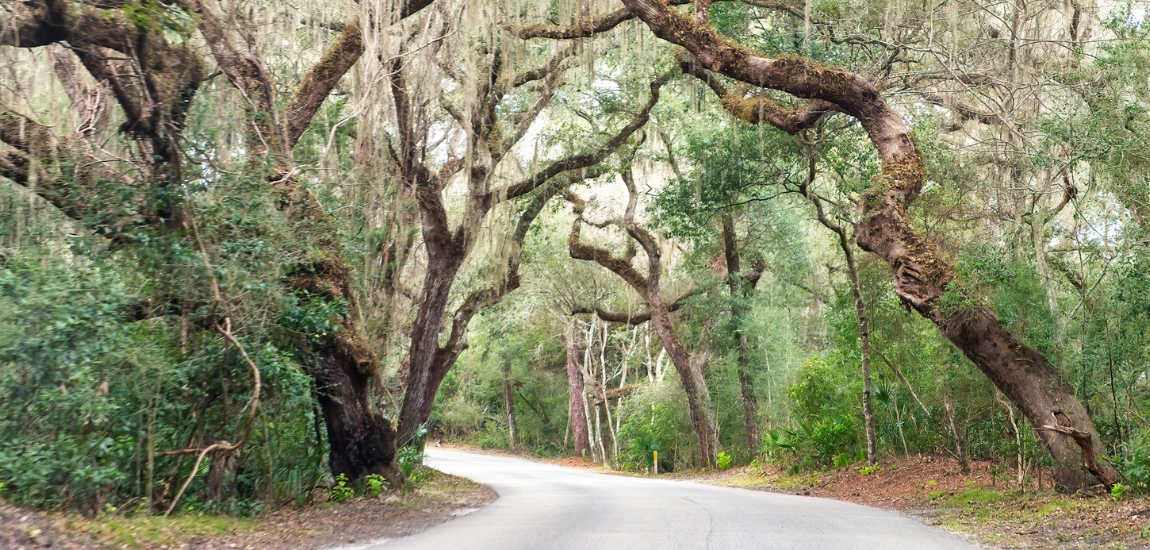Bulow Creek State Park is not just another patch of preserved wilderness in Florida—it’s a realm where time folds in eerie silence and centuries-old oak trees cast long shadows over whispered legends. Located just north of Ormond Beach, this hauntingly beautiful park is home to one of the largest live oak trees in the South—The Fairchild Oak—and the eerie remains of Bulow Plantation, a site stained with the stories of early settler hardship, war, and decay.
As the moss-draped trees sway with the Atlantic breeze, the atmosphere becomes dense with a strange mix of natural grandeur and supernatural mystery. It’s the perfect destination for anyone fascinated by haunted history, ghost walks, and a deep-rooted connection between the past and the living forest.
In this blog, we’ll walk you through the ghostly legends, historic significance, and spine-tingling moments that make Bulow Creek State Park an unforgettable experience for lovers of the strange and sublime.
The Fairchild Oak: Sentinel of the Spirits
Standing tall for over 400 years, The Fairchild Oak is perhaps the most iconic and mystifying landmark in Bulow Creek State Park. At over 70 feet tall and with limbs sprawling outward like arms guarding secrets, this tree has silently witnessed centuries of Florida’s history—both human and ghostly.
Named after Dr. David Fairchild, a renowned botanist, this massive oak is often said to be a spiritual magnet. Locals and visitors alike report feelings of unease and sudden chills when approaching it, especially during twilight hours. Some even claim to see ghostly figures lingering near its roots—perhaps former plantation workers, soldiers, or even the spirits of the native Timucuan people who once inhabited this land.
There’s a notable tale of a man who hung himself from one of the oak’s lower branches in the early 1800s, leaving behind a ghost story that lingers in whispered warnings and blurred sightings. Paranormal enthusiasts often describe camera glitches, strange shadows, and audio anomalies around the tree—prompting many to believe the Fairchild Oak isn’t just a tree, but a haunted portal to the past.
Despite the legends, there’s an undeniable peace under its canopy. The filtered sunlight, rustling leaves, and occasional owl hoot make it a paradoxical place: tranquil and terrifying all at once.

The Ruins of Bulow Plantation: Shadows of Tragedy
Just a few miles from the Fairchild Oak lie the Bulow Plantation Ruins Historic State Park, an evocative monument to a bygone era filled with grandeur, labor, and eventual destruction. Established in the early 1800s by Major Charles Wilhelm Bulow, this sugar plantation once sprawled across thousands of acres. Slaves worked the fields and operated the massive sugar mill, whose coquina foundations still stand today—now overgrown, cracked, and ghostly quiet.
During the Second Seminole War in 1836, the plantation was burned to the ground, leaving only skeletal remains of the sugar mill, chimney stacks, and holding vats. These ruins are now thought to be haunted by the very people who lived and died under brutal conditions on the land.
Many ghost hunters who visit the site report hearing whispers or footsteps crunching in the underbrush when no one else is around. Others mention orbs and light anomalies captured in photos, especially near the mill ruins. Some claim to have seen shadow figures darting between the coquina walls or experienced sudden emotional waves—sadness, anger, despair—that seem to come out of nowhere.
Whether these sensations are remnants of trauma or active hauntings, one thing’s certain: the ruins radiate a deep, heavy silence that feels both sacred and unsettling.
For history lovers, this site offers a raw, immersive glimpse into Florida’s plantation era. For ghost seekers, it’s a must-visit portal into the supernatural.

The Trails Where History Walks with the Dead
Bulow Creek isn’t just about its trees or ruins—it’s about the journey in between. The Bulow Woods Trail, stretching over 6.8 miles, is a hike unlike any other in Florida. Dense canopy, ancient root systems, and a thick layer of leaf litter silence footsteps and amplify every bird call and rustle. But beyond its natural charm, the trail is riddled with eerie energy.
Hikers often report an overwhelming feeling of being watched. Some turn around, expecting to see someone following them—only to find empty trail behind. Others have stumbled upon odd cold spots, even in the peak of summer, or reported electronic devices acting up without explanation.
There are unconfirmed accounts of ghost sightings along the trail—spectral figures dressed in 19th-century garb, often appearing and vanishing without a sound. Trail cameras and motion sensors placed by amateur investigators have allegedly caught unexplainable movements or static flashes in the middle of still night.
Interestingly, the deeper you go into the trail, the stronger the silence gets. Birds seem to stop chirping, and even wind disappears into stillness. Many hikers turn back before finishing—not out of fatigue, but due to the overwhelming sense that they’re not walking alone.
That said, the trail is well-marked and maintained. For those brave enough, hiking it near dusk (with proper gear and safety in mind) can be an unforgettable experience that blends natural beauty with ghostly encounters.

Tips for a Ghostly Yet Safe Visit to Bulow Creek
If you're planning a trip to Bulow Creek State Park for a spooky afternoon or a paranormal adventure, here are some practical tips to keep your visit safe and fulfilling:
-
Start Early: The park opens at 8 a.m. and closes at sunset. Arrive early to explore in daylight and capture the moody golden hour near dusk.
-
Bring a Journal or Recorder: Many visitors like to record sounds or take notes on strange sensations for later reflection.
-
Use Trail Maps: Trails can feel disorienting, especially under heavy canopy. Download a map beforehand or use GPS where service allows.
-
Travel in Groups: While solo hikes are serene, going with a group is safer, especially if you're exploring after 4 p.m.
-
Respect the Site: The ruins are protected. Don’t climb or remove anything. Be mindful of the spirits and the history.
-
Camera and Battery Backup: Phones and cameras sometimes drain inexplicably in haunted spots. Always carry backups if you’re capturing content.
-
Stay Open-Minded, But Skeptical: Whether you're a believer or not, approach with respect. Not every cold breeze is a ghost—but not every ghost needs proof either.
Conclusion: Where Time Whispers Through the Trees
Bulow Creek State Park is not just a destination—it’s an experience suspended between the real and the spectral. With its ancient trees, crumbling ruins, and trails laced with silence and shadows, it offers a different kind of Florida: one that lives in stories, in spirits, and in the subtle energy of the land.
Whether you come for the history, the haunting, or the sheer beauty of this protected wildland, a ghostly afternoon at Bulow Creek will leave a mark. The kind that lingers long after your footsteps fade into moss and memory.
So next time you’re near Ormond Beach, skip the usual beach day—and instead, step into a tale older than Florida itself.





Leave a Reply